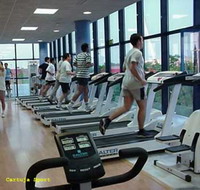More gyms aimed at serving older clients appear
Marshall Kahn attends a gym with yoga, tai chi and Pilates classes, weight training and treadmills. It also has a driving simulator, to keep skills from deteriorating.

The gym, Nifty After Fifty, is one of many fitness centers popping up around the U.S. aimed at serving older clients.
"I'm 80, my wife is 48. So I have to stay fit," said Kahn, who signed up at one of the company's four Los Angeles locations earlier this year and pays about $50 (37 EUR) per month to work out three times a week. "I joined a gym about three or four years ago, and I didn't like it at my age - it was young, noisy and frenetic. They were doing all these crazy things I couldn't participate in. Here, I'm not intimidated. I'm more inclined to go."
When it comes to designing a gym, it's not all about attracting the hard bodies anymore, and when it comes to senior fitness, there's more out there than water aerobics. As more of America's baby boomers start entering their 60s, more startup gyms are homing in on a more mature market.
"As we get older, we're sort of intimidated about going into a 25,000 square-foot gym with rock music and people in tight leotards and muscle bulging from every aspect of their tank shirts," said 74-year-old Sheldon Zinberg, who opened Nifty After Fifty last year.
Nifty After Fifty plays softer music than the typical gym, and uses smooth, air pressure-driven equipment for strength training as opposed to your typical metal weights. So does Healthfit, a club based in Needham, Massachusetts, where paintings adorn the walls and the average client is over 50. FitWright - a club that opened last fall in Dedham, which has seen particular interest recently from people in their 60s and 70s - offers a special "gentle yoga" class for its less limber members.
"I think more than half the calls I get, and there's no regionality to this, are about doing a senior-only health club," said John Atwood, who runs Healthfit and the consulting firm Club Management Group, which advises small or mid-size clubs. "There was very little of this in the '90s."
The business potential is huge, and expanding. Club 50, a fitness chain for the over-40 crowd that has mushroomed to more than 40 franchises since it began in 2003, points out that seniors control more than 70 percent of the country's disposable income.
And the oldest of the baby boomers, born between 1946 and 1964, started turning 60 last year. In less than 25 years, there will be more than 71 million 65-year-olds, twice as many as there were in 2000, according to the National Association of Area Agencies on Aging.
The U.S. health club industry pulls in about $16 billion (11.9 billion EUR) in annual revenue, according to data from the International Health, Racquet & Sportsclub Association. Over the last 20 years, the number of people with club memberships has more than doubled and the number of clubs has nearly tripled, IHRSA's data shows.
It's not only the growing number of retirees and their spending power - it's also their schedule. In the late morning and early afternoon, when most gyms are nearly empty, those that are popular among the gray-haired set are bustling.
"The average age at health clubs just went up to 37 years old. Here (at Healthfit), the average age is 53. In the middle of the day, the average age is about 80," Atwood said.
An older client's goals are a bit different from those of your typical gym hound. Sure, many want to lose weight, but they are particularly focused on improving their posture, lowering their cholesterol, increasing bone density against osteoporosis, alleviating joint pain and avoiding falls.
"They're not in it for the same things as the 35-year-olds," said Keith Wrightington, who runs FitWright. "They just want to feel better."
A senior-focused gym requires senior-focused equipment and a senior-focused staff. Many of them are hiring only fitness coaches with bachelor's or master's degrees in subjects like kinesiology, and keep in regular contact with members' primary care physicians to stay on top of their medications.
That's not to say that other clubs aren't drawing in the older set. One-third of IHRSA's more than 4,000 clubs have senior programming, the association said, and between 2000 and 2005 the number of members over the age of 55 climbed from 7.3 million to 7.9 million.
Subscribe to Pravda.Ru Telegram channel, Facebook, RSS!


